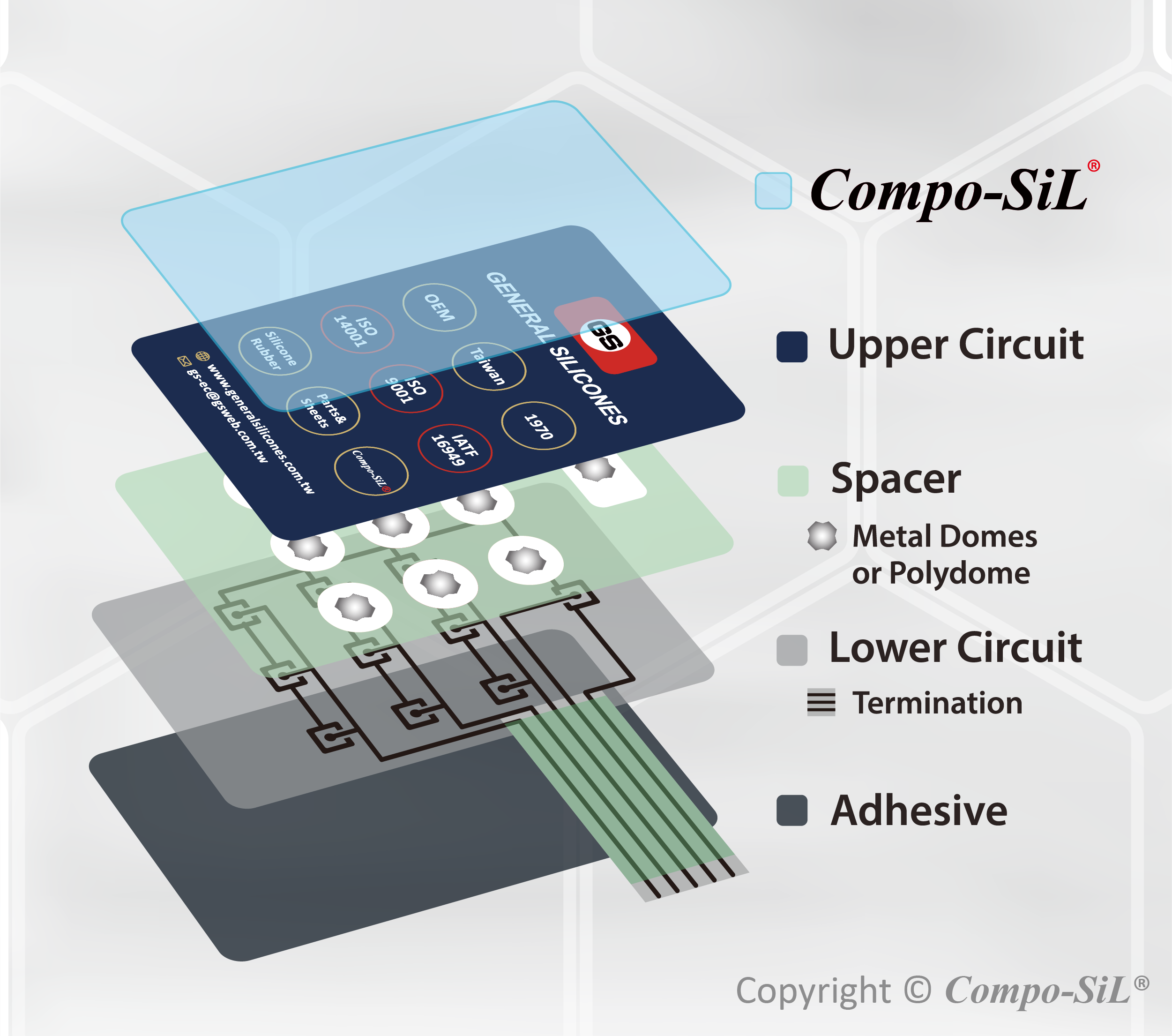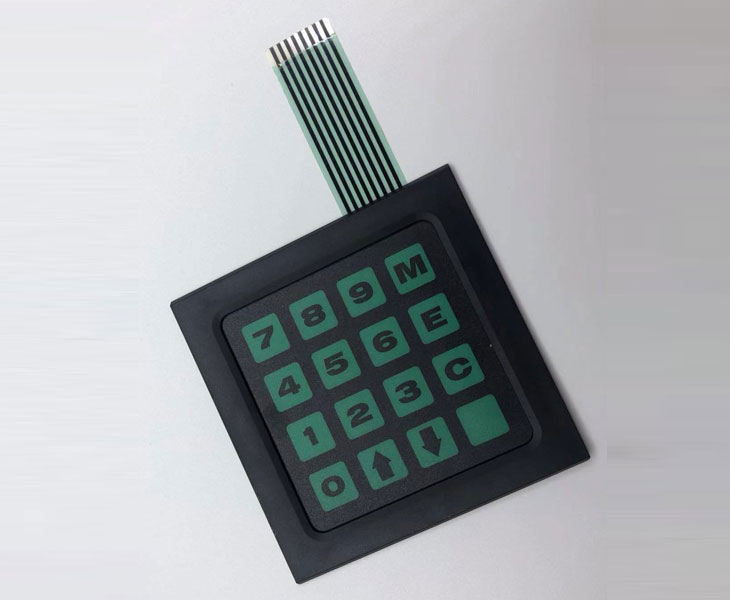The future of membrane switch in connected automotive systems
Wiki Article
Everything About Membrane layer Change: A Comprehensive Overview for Beginners
Membrane buttons are essential components in modern electronic devices, supplying a distinct interface for customer interaction - membrane switch. Their split construction, consisting of overlays and conductive traces, offers performance and toughness. Unlike conventional mechanical switches, membrane layer switches provide a streamlined layout and customizable choices. Understanding their crucial features and benefits can transform product style. However, the complexities of their application and layout factors to consider warrant further explorationWhat Is a Membrane Change?
A membrane button is a kind of electric button that contains a versatile membrane layer layered over a printed circuit board. This layout permits for a compact and streamlined user interface, typically utilized in different electronic gadgets. Membrane layer switches are frequently found in consumer appliances, medical tools, and commercial machinery as a result of their durability and resistance to ecological factors.The construction usually includes several layers, such as visuals overlays and sticky backing, which supply tactile feedback and shield the circuitry underneath. The procedure of a membrane button is started when stress is related to the surface, completing an electrical circuit.These switches are valued for their flexibility, enabling customized designs and printed graphics that deal with particular interface. Their low-profile nature decreases area requirements, making them suitable for applications where traditional buttons might not fit. Generally, membrane layer buttons offer a practical and visual service for contemporary digital tools.Key Parts of Membrane Switches Over
Membrane switches over consist of several essential elements that add to their capability and efficiency. The leading layer, called the overlay, supplies the interface and is typically printed with graphics or symbols. Below the overlay exists a spacer layer, which divides the conductive components and avoids inadvertent activation. The following crucial part is the graphic layer, which enhances looks and guarantees the durability of the design.Conductive traces, generally made from materials like silver or carbon, are printed on the circuit layer. When pressure is put on the overlay, these traces enter call, completing the circuit. Additionally, a backing layer supplies architectural support and can be made from products such as polyester or polycarbonate. With each other, these elements produce a dependable, user-friendly user interface appropriate for numerous applications, from household home appliances to industrial tools. Recognizing these aspects is vital for anyone thinking about membrane layer switch modern technology.Exactly How Membrane Layer Switches Over Work
Understanding how membrane layer changes feature is essential for appreciating their prevalent use in various devices. A membrane switch runs through a series of layers, consisting of a visuals overlay, spacer, and a circuit layer. When pressure is applied to the overlay, it compresses the spacer layer, permitting the circuit layer to make get in touch with and complete an electric circuit. This activity sends a signal to the gadget, triggering a reaction, such as activating a light or triggering a function.Membrane switches over can be designed with different attributes, including responsive responses, backlighting, and custom-made graphics, boosting individual interaction. Their construction enables a closed layout, protecting the internal parts from dirt, dampness, and impurities. This toughness makes them ideal for varied applications, from customer electronics to industrial devices. Overall, the simpleness and performance of membrane layer switches contribute to their popularity in modern innovation.Benefits of Membrane Layer Switches Mechanical Buttons
While mechanical buttons have long been a staple in numerous devices, membrane layer changes offer distinctive benefits that make them increasingly appealing. One considerable advantage is their slim profile, enabling even more compact designs and greater flexibility in item advancement. Additionally, membrane layer switches over function an uniform surface, which boosts aesthetic appeal and streamlines cleansing, making them suitable for environments where health is critical.Another benefit is their resistance to dirt and moisture. Unlike mechanical buttons, which can be jeopardized by ecological variables, membrane switches give a closed interface that secures versus pollutants - membrane switch. Membrane buttons usually have a longer life expectancy due to less moving parts, resulting in improved longevity and reliability.Cost-effectiveness is also a remarkable benefit, as membrane layer buttons can be generated in bulk with reduced production costs. These elements incorporate to position membrane switches as a check that sensible option to typical mechanical alternatives in numerous applicationsCommon Applications of Membrane Changes
Membrane layer switches are extensively utilized in various markets, especially in customer electronic devices and commercial control board. In consumer tools, they provide a streamlined, easy to use user interface, while in commercial settings, they improve sturdiness and capability. Comprehending these applications highlights the versatility and usefulness of membrane layer buttons in modern-day innovation.Consumer Electronics Devices
As customer electronics proceed to advance, membrane switches have ended up being a prominent selection for a range of devices as a result of their flexibility and smooth style. These switches are commonly located in smartphones, tablets, and remote controls, where area is limited and aesthetics matter. Their low account and personalized designs allow suppliers to develop easy to use interfaces that enhance the total individual experience. Furthermore, membrane buttons are commonly utilized in devices such as microwaves and coffee manufacturers, supplying user-friendly control alternatives while standing up to moisture and dust. The longevity and dependability of membrane changes make them appropriate for day-to-day consumer products, making certain long life and constant performance. In general, their assimilation in consumer electronic devices reflects a blend of capability and modern layout.Industrial Control Panels
The applications of membrane layer switches over expand past customer electronic devices, finding substantial use in industrial control panels. These switches are favored for their sturdiness and resistance to harsh environments, making them suitable for producing and procedure control settings. They provide a trusted user interface for drivers to regulate machinery, screen processes, and adjust settings. Membrane switches can be personalized to fit particular operational demands, integrating features like backlighting and responsive feedback, enhancing user experience. Their low-profile style enables for combination right into different devices, while their ability to stand up to spills, dirt, and extreme temperatures guarantees longevity. In general, membrane layer buttons add to reliable and risk-free operation in commercial applications, showing their flexibility and efficiency in requiring atmospheres.Factors To Consider for Designing Membrane Switches
When developing membrane layer switches, choosing the best materials is crucial to ensure sturdiness and functionality. In addition, recognizing layer configuration methods can considerably influence the switch's performance and user experience. These factors to consider play an essential function in producing trustworthy and effective membrane layer button styles.
Product Choice Value
Material selection plays a vital role in the layout and performance of membrane layer buttons. The selected products directly influence the button's durability, responsive feedback, and overall aesthetic. Trick considerations consist of the substrate, which should give architectural stability while enabling for flexibility, and the visuals overlay, which requires to be resistant to put on and environmental elements. Conductive products should assure dependable electric performance, while adhesives need to supply strong bonding without compromising the switch's operation. Additionally, compatibility with making procedures and end-user environments is crucial; products must hold up against differing temperatures, humidity levels, and chemical exposure. Eventually, ideal material option not only improves additional resources the membrane layer switch's performance yet also adds membrane switch to its long life and individual complete satisfaction, making it a critical facet of the layout procedure.
Layer Configuration Strategies

Regularly Asked Questions
Exactly How Long Do Membrane Layer Switches Over Generally Last?
Membrane layer buttons typically have a life-span of 1 to 5 million cycles, depending upon use and environmental problems. Variables such as design quality and operating frequency significantly influence their longevity and overall performance longevity.
Can Membrane Switches Be Personalized for Details Layouts?
Membrane layer switches can undoubtedly be tailored to fit specific styles, permitting varied forms, colors, and capabilities. This flexibility enables producers to tailor these switches to fulfill one-of-a-kind visual and functional needs effectively.What Products Are Used in Membrane Switch Building?
Membrane layer switches are commonly constructed using materials such as polyester, polycarbonate, and sticky layers. These products supply adaptability, longevity, and resistance to ecological aspects, making certain the buttons function efficiently in various applications and conditions.
Are Membrane Switches Over Resistant or water resistant to Wetness?
Membrane layer switches can be developed to be moisture-resistant, using specialized materials and finishes. However, their water resistant capabilities depend upon building high quality and details applications, making it important to assess requirements for excellent efficiency in different environments.Just How Are Membrane Switches Repaired if Harmed?
Repairing broken membrane layer switches over normally involves replacing the impacted layer or circuit. Technicians may additionally use conductive adhesive or use specialized repair kits, ensuring capability is restored without total replacement of the whole button setting up. Unlike conventional mechanical switches, membrane layer buttons provide a sleek style and adjustable alternatives. A membrane layer button is a type of electric button that consists of an adaptable membrane layered over a published circuit board. The procedure of a membrane layer switch is started when stress is used to the surface area, completing an electric circuit.These switches are valued for their versatility, allowing custom layouts and published graphics that provide to particular customer interfaces. While mechanical buttons have long been a staple in several tools, membrane switches deal unique benefits that make them significantly appealing. Membrane layer buttons usually have a longer lifespan due to fewer relocating components, resulting in boosted resilience and reliability.Cost-effectiveness is also a noteworthy benefit, as membrane layer buttons can be produced in bulk with lower production expenses.Report this wiki page